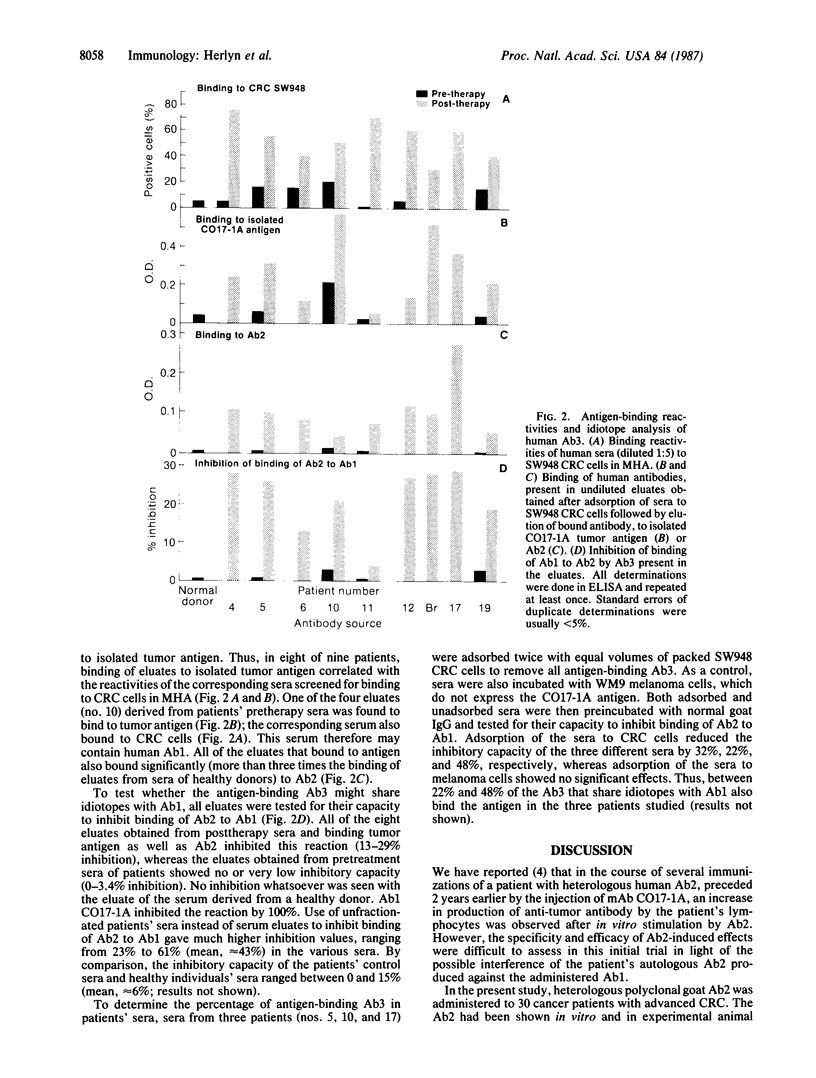Abstract
Thirty patients with advanced colorectal carcinoma (CRC) were treated with alum-precipitated polyclonal goat anti-idiotypic antibodies (Ab2) to monoclonal anti-CRC antibody CO17-1A (Ab1) in doses between 0.5 and 4 mg per injection. All patients developed anti-anti-idiotypic antibodies (Ab3) with binding specificities on the surfaces of cultured tumor cells similar to the specificity of Ab1. Furthermore, the Ab3 competed with Ab1 for binding to CRC cells. Fractions of Ab3-containing sera obtained after elution of the serum immunoglobulins from CRC cells bound to purified tumor antigen and inhibited binding of Ab2 to Ab1. The Ab3, therefore, may share idiotopes with Ab1. Six patients showed partial clinical remission and seven patients showed arrest of metastases following immunotherapy. Four of the thirteen patients with measurable clinical responses had received Ab2 alone, whereas 9 patients had also received chemotherapy.
Full text
PDF




Images in this article
Selected References
These references are in PubMed. This may not be the complete list of references from this article.
- DeFreitas E., Suzuki H., Herlyn D., Lubeck M., Sears H., Herlyn M., Koprowski H. Human antibody induction to the idiotypic and anti-idiotypic determinants of a monoclonal antibody against a gastrointestinal carcinoma antigen. Curr Top Microbiol Immunol. 1985;119:75–89. doi: 10.1007/978-3-642-70675-2_6. [DOI] [PubMed] [Google Scholar]
- Herlyn D. M., Steplewski Z., Herlyn M. F., Koprowski H. Inhibition of growth of colorectal carcinoma in nude mice by monoclonal antibody. Cancer Res. 1980 Mar;40(3):717–721. [PubMed] [Google Scholar]
- Herlyn D., Koprowski H. IgG2a monoclonal antibodies inhibit human tumor growth through interaction with effector cells. Proc Natl Acad Sci U S A. 1982 Aug;79(15):4761–4765. doi: 10.1073/pnas.79.15.4761. [DOI] [PMC free article] [PubMed] [Google Scholar]
- Herlyn D., Lubeck M., Sears H., Koprowski H. Specific detection of anti-idiotypic immune responses in cancer patients treated with murine monoclonal antibody. J Immunol Methods. 1985 Dec 17;85(1):27–38. doi: 10.1016/0022-1759(85)90271-6. [DOI] [PubMed] [Google Scholar]
- Herlyn D., Ross A. H., Koprowski H. Anti-idiotypic antibodies bear the internal image of a human tumor antigen. Science. 1986 Apr 4;232(4746):100–102. doi: 10.1126/science.3952496. [DOI] [PubMed] [Google Scholar]
- Herlyn D., Sears H., Iliopoulos D., Lubeck M., Douillard J. Y., Sindelar W., Tempero M., Mellstedt H., Maher M., Koprowski H. Anti-idiotypic antibodies to monoclonal antibody CO17-1A. Hybridoma. 1986 Jul;5 (Suppl 1):S51–S58. [PubMed] [Google Scholar]
- Herlyn M., Steplewski Z., Herlyn D., Clark W. H., Jr, Ross A. H., Blaszczyk M., Pak K. Y., Koprowski H. Production and characterization of monoclonal antibodies against human malignant melanoma. Cancer Invest. 1983;1(3):215–224. doi: 10.3109/07357908309041361. [DOI] [PubMed] [Google Scholar]
- Herlyn M., Steplewski Z., Herlyn D., Koprowski H. Colorectal carcinoma-specific antigen: detection by means of monoclonal antibodies. Proc Natl Acad Sci U S A. 1979 Mar;76(3):1438–1442. doi: 10.1073/pnas.76.3.1438. [DOI] [PMC free article] [PubMed] [Google Scholar]
- Kennedy R. C., Adler-Storthz K., Henkel R. D., Sanchez Y., Melnick J. L., Dreesman G. R. Immune response to hepatitis B surface antigen: enhancement by prior injection of antibodies to the idiotype. Science. 1983 Aug 26;221(4613):853–855. doi: 10.1126/science.6603657. [DOI] [PubMed] [Google Scholar]
- Koprowski H., Herlyn D., Lubeck M., DeFreitas E., Sears H. F. Human anti-idiotype antibodies in cancer patients: Is the modulation of the immune response beneficial for the patient? Proc Natl Acad Sci U S A. 1984 Jan;81(1):216–219. doi: 10.1073/pnas.81.1.216. [DOI] [PMC free article] [PubMed] [Google Scholar]
- Koprowski H., Steplewski Z., Mitchell K., Herlyn M., Herlyn D., Fuhrer P. Colorectal carcinoma antigens detected by hybridoma antibodies. Somatic Cell Genet. 1979 Nov;5(6):957–971. doi: 10.1007/BF01542654. [DOI] [PubMed] [Google Scholar]
- Pfreundschuh M. G., Ueda R., Rauterberg E. W., Dörken B. H., Shiku H. Comparison of multiple rosetting assays for detecting antibody reactivity of different immunoglobulin classes against surface antigens of benign and malignant tissue culture cells. J Immunol Methods. 1980;37(1):71–81. doi: 10.1016/0022-1759(80)90182-9. [DOI] [PubMed] [Google Scholar]
- Ross A. H., Herlyn D., Iliopoulos D., Koprowski H. Isolation and characterization of a carcinoma-associated antigen. Biochem Biophys Res Commun. 1986 Feb 26;135(1):297–303. doi: 10.1016/0006-291x(86)90976-9. [DOI] [PubMed] [Google Scholar]
- Sanchez Y., Ionescu-Matiu I., Dreesman G. R., Kramp W., Six H. R., Hollinger F. B., Melnick J. L. Humoral and cellular immunity to hepatitis B virus-derived antigens: comparative activity of Freund complete adjuvant alum, and liposomes. Infect Immun. 1980 Dec;30(3):728–733. doi: 10.1128/iai.30.3.728-733.1980. [DOI] [PMC free article] [PubMed] [Google Scholar]
- Sears H. F., Herlyn D., Steplewski Z., Koprowski H. Effects of monoclonal antibody immunotherapy on patients with gastrointestinal adenocarcinoma. J Biol Response Mod. 1984;3(2):138–150. [PubMed] [Google Scholar]
- Sears H. F., Herlyn D., Steplewski Z., Koprowski H. Phase II clinical trial of a murine monoclonal antibody cytotoxic for gastrointestinal adenocarcinoma. Cancer Res. 1985 Nov;45(11 Pt 2):5910–5913. [PubMed] [Google Scholar]




